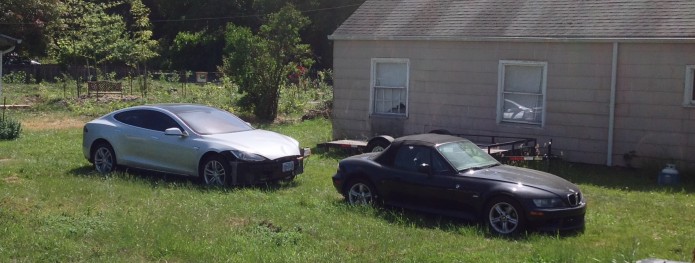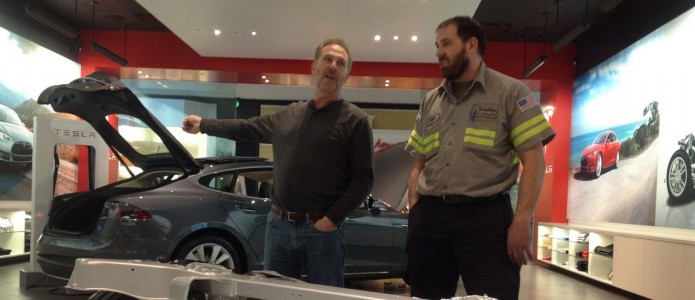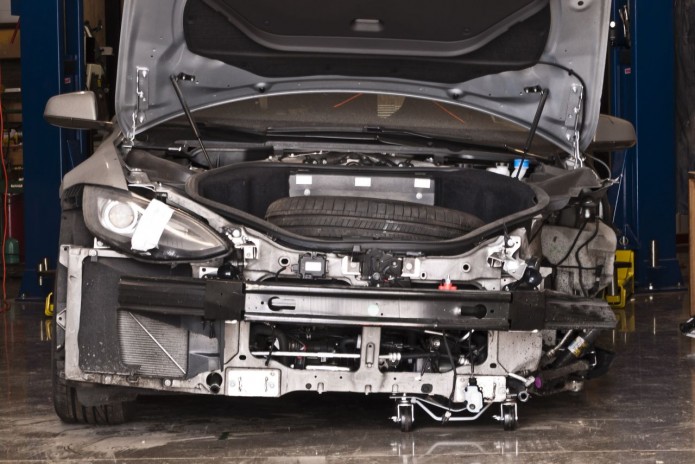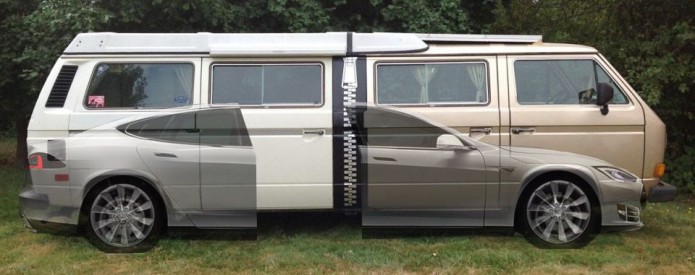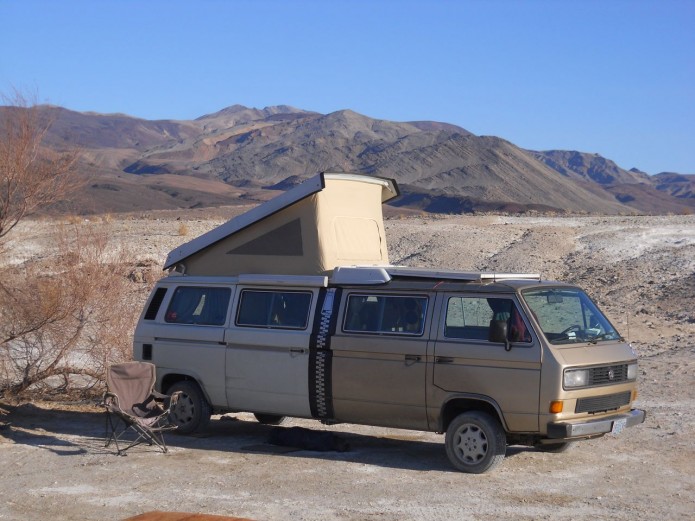Parked Wreckla, Pariah at Pasture
Petty Problems Purchasing Parts.
With my delayed schedule, some people in this great cesspool of an internet have jumped to the conclusion that I’m just too addicted to driving the Wreckla to dismantle it and build the Stretchla. I can see how that might seem like a reasonable assumption but I’m here to tell you it’s not the case. I voluntarily chose to stop driving the Wreckla shortly after I verified proper charging at the Supercharger. Why I did that deserves some explanation. Normally I would find it fun to drive some hacked up barely legal unsafe vehicle on the street, so why am I not doing that now? It started with an email out of the blue from my local Tesla parts department:
“Due to the salvage status of your Model S , I have been instructed to cease providing you with parts. Tesla is very concerned about vehicles with salvaged titles being improperly repaired. Going forward, all salvaged vehicles must be inspected by us or our approved body shop, Precision Auto Body. If declared a candidate for proper repair, reconstruction must be completed by a Tesla-Certified Body Shop.”
Ouch!
Funny how one email can change so much.
I have no doubt that my Wreckla qualifies as the poster child of an “improperly repaired” vehicle. As you can imagine the email brought me a number of emotions. The first was a feeling of rejection. I like Tesla, I give them good money for parts, most of my investment portfolio is in Tesla stock, what have I done to upset them? Does Tesla not love me anymore? Fear; what am I going to do with the Stretchla if some crucial part breaks when I’m thousands of miles from home? Concern; what does this do to the salvaged and used Tesla market? Will people with salvage Teslas now be more likely to run them in unsafe condition, or even be unable to drive them at all? It stinks of big brother at first look, and I don’t know if I like it. They must have some good reason for this policy.
Once I got over the shock, I started to analyze what I figure this means to me, as well as for others.
First of all, it was not that big of a shock to me. I’ve heard of others with salvage Teslas unable to buy parts before me, I feel very grateful that I was able to buy as many parts as I did. I do wish that I had bought the front sway bar and drop link before this happened, but I’m sure I’ll find used parts somewhere.
I already learned that auto manufacturers have no legal requirement to provide replacement parts at all. They choose to supply individual parts for a number of reasons. For starters, if manufacturers didn’t have parts they would have to replace the entire car for any warranty issue. That could get expensive fast. There is also the issue of resale value. The resale value of a brand affects the desirability of cars and value falls quite a bit if parts and service are not readily available at a reasonable cost. In this case I expect this policy will reduce the resale value of salvaged Teslas quite a bit, but does that matter to the overall goal of the company to “to accelerate the advent of sustainable transport by bringing compelling mass market electric cars to market as soon as possible”? I estimate that less than one half of one percent of Teslas have been totalled. Maybe a few people will feel uncomfortable buying a car that would be unrecoverable from a salvage title event, but I suspect that in the end this policy will have a very tiny impact on the market for Teslas.
My primary question was “why are they doing this?” I asked if they had any more to say, but Tesla provided no further explanation so it’s up to us to speculate. The best explanation I’ve heard so far was from a friend who talked about the excellent safety record of the Model S and how it interacts with our dysfunctional media. Remember what happened when Tesla’s slowly caught fire many long minutes after impacting large destructive objects on the road? The media made a sensation out of a non-event and Elon Musk admitted demand for the Model S fell. Now imagine if you will, what would happen if I was killed in an accident in my unsafe Tesla? I can see the headlines now: “Man Killed in Model S, Are EV’s Safe?” (Note to media reading this, this is not a real headline, do not quote me out of context!) Maybe somewhere down in the fourth paragraph they might mention that I was driving a salvage title car with a cracked frame and the air bags disabled fully aware of the danger, but that’s not what the world would remember, they would just eat up the headline and believe the media fairy tale. Of course people die all the time in other cars, but this is still a special time for Tesla and the first fatality is bound to be a media circus. I hope it is still far off. (Edit: Since I first wrote this there has been one fatality of an alleged thief of a Tesla that split in in half using a light pole in Hollywood at a very high rate of speed)
I love that EV’s are finally being taken seriously. I believe it’s all due to Tesla succeeding in the market. I don’t want to risk an event that might have a strong negative effect on that success. That’s the reason I’ve parked the “Wreckla.” I still reposition it around the yard as needed and I did recently drive it to a shop where we drained the freon out of the air conditioning system, but since then I’ve even removed it from my insurance. Still, every time I open the door to that spaceship, my Slacker station starts playing and I’m all the more excited to get that system swapped over to the Stretchla!
As for others who own salvage Teslas, we’ll have to see what happens. The current wording of the statement is not very flexible. I expect that most any car that was “salvaged” was damaged so much that it did not make financial sense to repair it at a “Tesla-Certified Body Shop.” Most people that rebuild salvaged vehicles use less expensive methods like combining parts from many salvaged vehicles. This is the first that I’ve heard of a manufacturer playing at the role of safety police. It seems to me that Tesla puts itself in an odd position taking on the role traditionally held by government regulations of controlling safety. I’ve heard rumor that Mercedes has very different policy. I’ve heard they sell “safety relevant items” such as brakes and air bags at cost to encourage people to keep their cars safe. People have contacted me about these issues and already I know of some very unsafe “repairs” that are being done on Teslas to try to drive the car without Tesla support. Hacking may be encouraged as well so long as Tesla does not provide basic service access and especially when the service center refuses to work on unapproved salvaged cars. How many people will not be able to do something as simple as bleed the coolant due to being on a Tesla black list? I know that encourages me to find a work around which may persuade me to share hacking information with others. But I really don’t want to do that, I’m not sure that public hacks are in the best interest of safe vehicles.
The more I look at this question, the more difficult it looks. Personal motivation aside, I don’t know what I think is best for Tesla and their honorable mission. Tesla is still a young company, they have yet to publicly address Right to Repair pressures. I expect this policy is an early work and I hope it will change in time. I hope Tesla does allow independent facilities to access parts and basic necessary tool data. I’m keeping up the hope that Tesla is working on a longer term vision that will support all Tesla owners without relegating owners with branded titles, like me, to some sort of third class status.
As for getting parts I may need to keep the Stretchla running (once I finish it), I don’t know what I’ll do about that. Eventually there will be more wrecks in the junkyards, that should help. Maybe Tesla will mature it’s policy in some way that helps me and maybe they will release open repair tools too. I’ll just stay hopeful and play it one day at a time.
